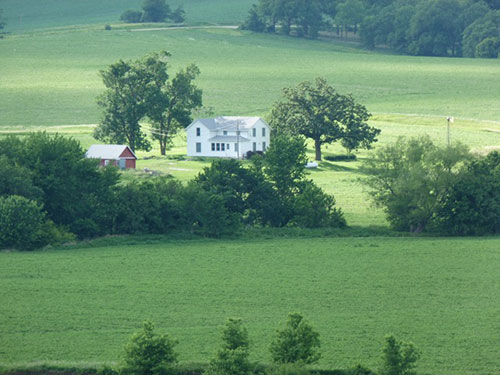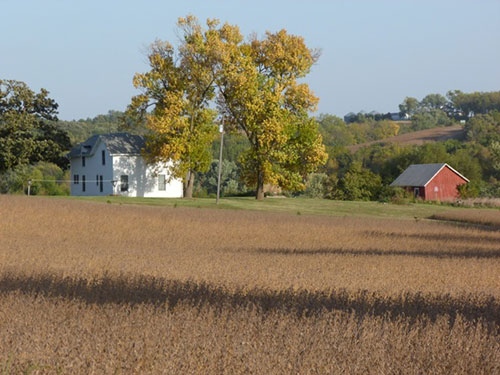

By Jerry Bowen
Los Angeles, CA, USA

Jerry Bowen
A frost warning was out as we drove down the long lane to the old farmhouse this past spring. Just what people wanted. More cold after a bitterly cold winter that knocked out most folk's Knockout Roses and turned promising wind breaks of small pine trees dead brown.
Weather is the wild card here in west central Iowa as it has been for generations of farm families carving out a life in these rolling hills. Last year the drought hammered the plains states. This spring began with hope. The seasonal optimism that the rains will come again and there'll be a bumper crop to make up for the falling corn and soybean prices.
The frost warning turned out to be not so much. The cherry and apple trees in our back yard kept their blossoms and the birds were everywhere to welcome us back.
Baltimore Orioles were right outside the kitchen window atop a make shift feeder devouring grape jelly we put out. Red Headed Woodpeckers were down in the grass after tasty bugs. And the Blue Bird couple flitted in and out of the house I'd nailed to the yard light pole a few years ago bringing food to their hatchlings.
Our friends in Los Angeles ask what it is that we do out here, miles from the nearest small towns and the stores where we shop for food and gardening supplies and more. My wife and I say we enjoy the quiet. We decompress in the splendid isolation. The house is down a very long lane from the gravel road that links us to our neighbors. The land has been in my family since 1863. It is a magic place.
The neighbors are special people. Fourth generation farm families that have stayed here to work the soil and raise families. Vi and Darrell, in their early 80's, live on the next farm over. A quarter mile to the North. Generous people.

Bowen Farmhouse, Audubon County, Iowa
Vi gifts us with wild asparagus each spring, and rhubarb that's just come in, and fresh bread she's experimenting with. This time it was a wheat bread with less molasses than usual. Kinda firm but great toasted.
Darrell shares stories from his father and grandfather about my great-grandfather and great-great grandfather from back in the day. And along with the stories a shot or two of Templeton's, the local rye whiskey said to be Al Capone's favorite during Prohibition.
Darrell also shares his live trap with me. Spring and fall. Important because each spring and fall I have a groundhog that burrows under the old house. They are also known as woodchucks and whistle pigs and to some they look furry and cute. But they have sharp claws and mouth of sharper teeth and they can really damage a house, electrical to plumbing lines, if they get bored sleeping in their burrow.
The art of live trapping is simple. Bait the metal cage with something that attracts the critter. I use sliced apples. Works every time. Then position the trap at the hole they've dug under the foundation and seal it off so the only way out is into the trap. And then wait.
I had one groundhog that wanted those apples so badly he (or she) actually dug a new hole under the foundation to get at the treat. Big mistake. The animal scampered on the pressure plate to reach the apples. The plate released the trap door and that hog was history.
Groundhogs are easy to get rid of. Some people shoot them to prevent them from coming back. I drive them 8 miles away to a wilderness park and let them out. Skunks are another matter. If you've ever smelled a skunk you know why.
Vi and Darrell have a friend who is legendary in this part of the state. He is a skunk whisperer. He live traps them to get them out of his barn and then he releases them back to the wild and he's never been sprayed. Not once.
Skunks are nocturnal creatures he explains. They run around at night. By morning they're pretty docile. He does talk to them as he opens the trap door but mostly they are so lethargic they just amble off. To spray another day. Somewhere and someone else.
The weather did start out really promising back in the spring. There was rain and lots of it. So much that farmers couldn't get into their fields to finish planting for a time. But they did and tiny corn and bean plants began popping up.
It is said that a person can hear the corn grow. Maybe. But from day-to-day the change is very visible. The Walker brothers, Joe and Bill, rent our land and rotate crops. Corn one year. Soybeans the next. During the corn years our house almost disappears behind the fields of nine-foot-tall stalks.

Bowen Farmhouse, Audubon County, Iowa
- Fall with Soybean Field
This is a corn year. But I don't know what we'll see when we return for the fall visit. That's because too much of a good thing turned into something awful. Mother Nature slapped a wild card down on field after field. "You want rain? Oh you'll get rain alright. And a little something extra."
June and July brought storms that some farmers had never experienced. Five inches of rain in 25 minutes in some places and baseball-sized hail, baseball-sized! Where there wasn't standing water there was row-after-row of shredded crops.
The winds came too. Punishing high winds that bent corn rows and toppled trees. Including that old apple tree we had such hope for in our backyard. The loss is much bigger for the Walker brothers and other area farmers.
The fields hit hardest may still give up something but far less than a normal harvest. This means growers won't have the high yield, the volume they need to make up for the low corn prices. Corn was selling for over $8 dollars a bushel two years ago. Now it's hovering around $3.50. Ugly math. Anyway you do it.
The fall visit means getting the old place ready for winter. There's always painting to be done. Upstairs hallway floor inside. The eaves and fascia trim outside. A second story job that I may hire young legs to do.
The Peony beds need to be cut and the fallen apple tree sawed to firewood size for the fire pit.
There will be many nights at the fire pit with fresh popped corn and neighbors to catch up with. Maybe a harvest moon to see. I don't know for sure. The coyotes should be around though. A pack in the distant west and another on the east side of the farm howling.
I will sit there late into the night with the red-hot coals and crackling elm wood and think fondly of the ancestors I never knew. They had no idea of what they were creating. It is a humbling experience. All of it. Every single time.





